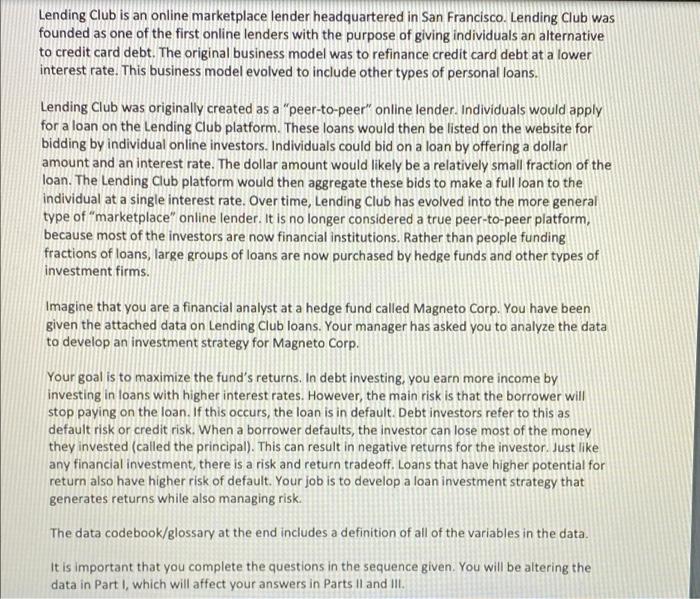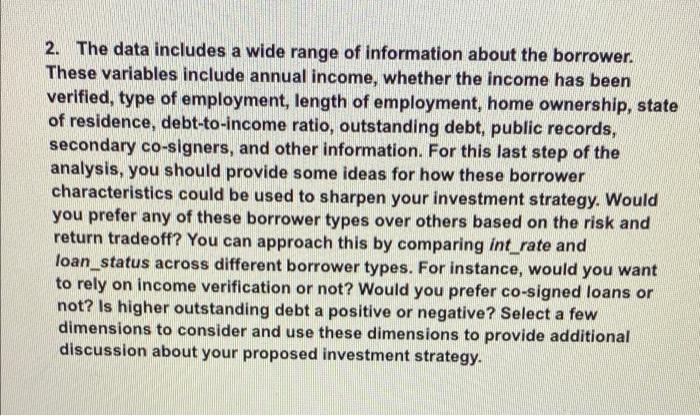Lending Club is an online marketplace lender headquartered in San Francisco. Lending Club was founded as one of the first online lenders with the purpose of giving individuals an alternative to credit card debt. The original business model was to refinance credit card debt at a lower interest rate. This business model evolved to include other types of personal loans. Lending Club was originally created as a "peer-to-peer" online lender. Individuals would apply for a loan on the Lending Club platform. These loans would then be listed on the website for bidding by individual online investors. Individuals could bid on a loan by offering a dollar amount and an interest rate. The dollar amount would likely be a relatively small fraction of the loan. The Lending Club platform would then aggregate these bids to make a full loan to the individual at a single interest rate. Over time, Lending Club has evolved into the more general type of "marketplace" online lender. It is no longer considered a true peer-to-peer platform, because most of the investors are now financial institutions. Rather than people funding fractions of loans, large groups of loans are now purchased by hedge funds and other types of investment firms. Imagine that you are a financial analyst at a hedge fund called Magneto Corp. You have been given the attached data on Lending Club loans. Your manager has asked you to analyze the data to develop an investment strategy for Magneto Corp. Your goal is to maximize the fund's returns. In debt investing, you earn more income by investing in loans with higher interest rates. However, the main risk is that the borrower will stop paying on the loan. If this occurs, the loan is in default. Debt investors refer to this as default risk or credit risk. When a borrower defaults, the investor can lose most of the money they invested (called the principal). This can result in negative returns for the investor. Just like any financial investment, there is a risk and return tradeoff. Loans that have higher potential for return also have higher risk of default. Your job is to develop a loan investment strategy that generates returns while also managing risk. The data codebook/glossary at the end includes a definition of all of the variables in the data. It is important that you complete the questions in the sequence given. You will be altering the data in Part I, which will affect your answers in Parts II and III. 2. The data includes a wide range of information about the borrower. These variables include annual income, whether the income has been verified, type of employment, length of employment, home ownership, state of residence, debt-to-income ratio, outstanding debt, public records, secondary co-signers, and other information. For this last step of the analysis, you should provide some ideas for how these borrower characteristics could be used to sharpen your investment strategy. Would you prefer any of these borrower types over others based on the risk and return tradeoff? You can approach this by comparing int_rate and loan_status across different borrower types. For instance, would you want to rely on income verification or not? Would you prefer co-signed loans or not? Is higher outstanding debt a positive or negative? Select a few dimensions to consider and use these dimensions to provide additional discussion about your proposed investment strategy. Lending Club is an online marketplace lender headquartered in San Francisco. Lending Club was founded as one of the first online lenders with the purpose of giving individuals an alternative to credit card debt. The original business model was to refinance credit card debt at a lower interest rate. This business model evolved to include other types of personal loans. Lending Club was originally created as a "peer-to-peer" online lender. Individuals would apply for a loan on the Lending Club platform. These loans would then be listed on the website for bidding by individual online investors. Individuals could bid on a loan by offering a dollar amount and an interest rate. The dollar amount would likely be a relatively small fraction of the loan. The Lending Club platform would then aggregate these bids to make a full loan to the individual at a single interest rate. Over time, Lending Club has evolved into the more general type of "marketplace" online lender. It is no longer considered a true peer-to-peer platform, because most of the investors are now financial institutions. Rather than people funding fractions of loans, large groups of loans are now purchased by hedge funds and other types of investment firms. Imagine that you are a financial analyst at a hedge fund called Magneto Corp. You have been given the attached data on Lending Club loans. Your manager has asked you to analyze the data to develop an investment strategy for Magneto Corp. Your goal is to maximize the fund's returns. In debt investing, you earn more income by investing in loans with higher interest rates. However, the main risk is that the borrower will stop paying on the loan. If this occurs, the loan is in default. Debt investors refer to this as default risk or credit risk. When a borrower defaults, the investor can lose most of the money they invested (called the principal). This can result in negative returns for the investor. Just like any financial investment, there is a risk and return tradeoff. Loans that have higher potential for return also have higher risk of default. Your job is to develop a loan investment strategy that generates returns while also managing risk. The data codebook/glossary at the end includes a definition of all of the variables in the data. It is important that you complete the questions in the sequence given. You will be altering the data in Part I, which will affect your answers in Parts II and III. 2. The data includes a wide range of information about the borrower. These variables include annual income, whether the income has been verified, type of employment, length of employment, home ownership, state of residence, debt-to-income ratio, outstanding debt, public records, secondary co-signers, and other information. For this last step of the analysis, you should provide some ideas for how these borrower characteristics could be used to sharpen your investment strategy. Would you prefer any of these borrower types over others based on the risk and return tradeoff? You can approach this by comparing int_rate and loan_status across different borrower types. For instance, would you want to rely on income verification or not? Would you prefer co-signed loans or not? Is higher outstanding debt a positive or negative? Select a few dimensions to consider and use these dimensions to provide additional discussion about your proposed investment strategy








